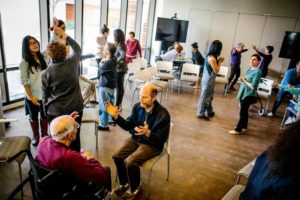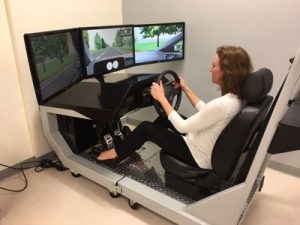 The winter issue of Stanford Medicine features an article on Dance for PD, a program that offers dance classes to people with Parkinson’s disease. “As physicians, we stress the importance of physical activity, social interaction and mental stimulation to our patients with Parkinson’s disease,” Helen Bronte-Stewart, Stanford neurologist, said. “Dance for PD gives them all three. But it is much more than a possible therapy or treatment; the PD dancers have told us this type of dance restores their self-image and brings them joy.”… Full Story>
The winter issue of Stanford Medicine features an article on Dance for PD, a program that offers dance classes to people with Parkinson’s disease. “As physicians, we stress the importance of physical activity, social interaction and mental stimulation to our patients with Parkinson’s disease,” Helen Bronte-Stewart, Stanford neurologist, said. “Dance for PD gives them all three. But it is much more than a possible therapy or treatment; the PD dancers have told us this type of dance restores their self-image and brings them joy.”… Full Story>
Archives for February 2017
Driving Rehabilitation session scheduled Thursday, March 2, 10:30-11:30am, Stanford

This driving rehabilitation session will discuss the topics of the aging driver and requirements by the California DMV in a driver has had a change in medical status (such as being diagnosed with Parkinson’s Disease). The session will be held at the Stanford Neuroscience Health Center. The program is free but advance registration is required.
Mobility crisis? Non-driving seniors navigate ridesharing options
 The Palo Alto Weekly published a terrific article on the difficulty in area residents (Palo Alto and Menlo Park) in getting around if they are no longer driving a vehicle. The article focuses on private transportation options available to seniors.
The Palo Alto Weekly published a terrific article on the difficulty in area residents (Palo Alto and Menlo Park) in getting around if they are no longer driving a vehicle. The article focuses on private transportation options available to seniors.Home Care Assistance: 5 Ways to Prevent Falls for the Seniors You Love
 Falls are one of the most dangerous things that a senior can experience. They can lead to hospitalizations, injuries, long-term health problems and even death. Statistics from the Centers for Disease Control(CDC) illustrate just how dangerous falls can be…. Full Story>
Falls are one of the most dangerous things that a senior can experience. They can lead to hospitalizations, injuries, long-term health problems and even death. Statistics from the Centers for Disease Control(CDC) illustrate just how dangerous falls can be…. Full Story>
New York Times: Hunched Over a Microscope, He Sketched the Secrets of How the Brain Works
 Some microscopes today are so powerful that they can create a picture of the gap between brain cells, which is thousands of times smaller than the width of a human hair. They can even reveal the tiny sacs carrying even tinier nuggets of information to cross over that gap to form memories. And in colorful snapshots made possible by a giant magnet, we can see the activity of 100 billion brain cells talking…. Full Story>
Some microscopes today are so powerful that they can create a picture of the gap between brain cells, which is thousands of times smaller than the width of a human hair. They can even reveal the tiny sacs carrying even tinier nuggets of information to cross over that gap to form memories. And in colorful snapshots made possible by a giant magnet, we can see the activity of 100 billion brain cells talking…. Full Story>